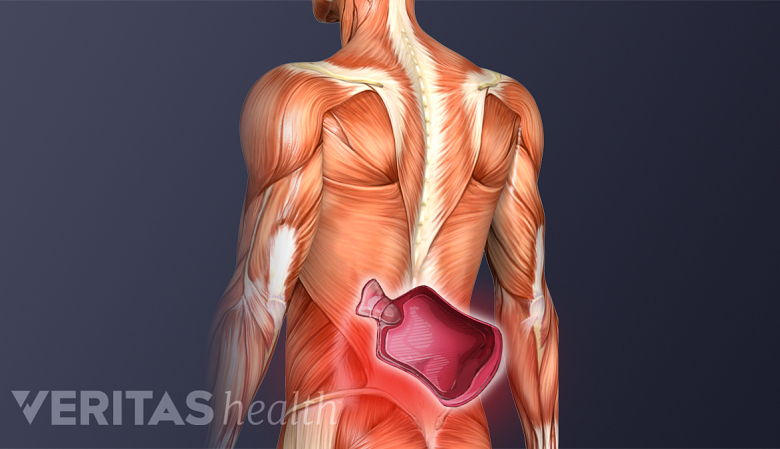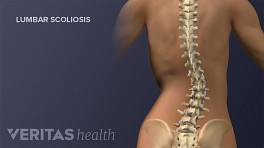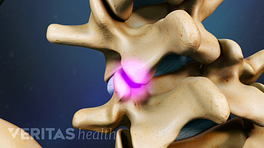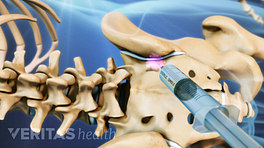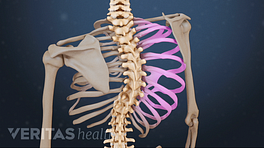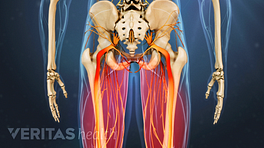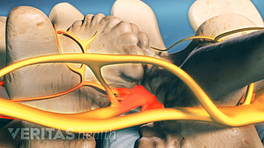When degenerative scoliosis becomes symptomatic, the main goal of treatment is to reduce pain and/or any accompanying neurologic symptoms. Treatment does not tend to focus on correcting the curve because that is typically not the cause of pain, nor is the curve likely to progress enough to cause a deformity.
Most cases of symptomatic degenerative scoliosis can be treated non-surgically with self-care and/or guidance from a medical professional.
In This Article:
- All About Degenerative Scoliosis
- Degenerative Scoliosis Symptoms and Diagnosis
- Treatment for Degenerative Scoliosis
- Surgery for Degenerative Scoliosis
- Degenerative Scoliosis Video
Treatments to Increase Strength and Mobility
As with most back pain, increasing strength and mobility can both relieve pain and reduce the risk for pain to recur in the future. Treatments that can help strengthen the back and/or keep it flexible include:
- Physical therapy. A physical therapist or other qualified medical professional can help develop an exercise and stretching routine to meet the patient’s specific needs. Physical therapy can help keep the soft tissues and joints limber as well as strengthen the targeted muscles.
- Pool therapy. Some exercises, such as water therapy, can be done in a pool. The body’s natural buoyancy in water helps counteract the effects of gravity, enabling patients to condition muscles while putting less stress on the facet joints.
Some people might find other treatments also help, such as massage therapy to help boost blood circulation and loosen muscles and joints.
Medications for Degenerative Scoliosis
NSAIDs provide anti-inflammatory effects and help calm inflammation and pain in the back.
Sometimes medications can help eliminate pain or at least reduce pain enough so that a physical therapy program can move forward. Some common medication options for degenerative scoliosis include:
- Pain relievers. Nonsteroidal anti-inflammatory drugs (NSAIDs), such as ibuprofen or medications that treat inflammation from arthritis (e.g. Celebrex) can help reduce pain. Acetaminophen (e.g. Tylenol) is another common option. Avoidance of narcotic pain medication is generally recommended except in rare circumstances when all else has failed to alleviate the symptoms.
- Injections. Epidural steroid injections can reduce inflammation, or a facet block injection can block pain signals from reaching the brain. These types of injections deliver the anti-inflammatory medication directly to the affected area in the back via needle and X-ray guidance.
It should be noted that medications can not heal what causes degenerative scoliosis to be painful, but they might be able to temporarily reduce pain so a person can complete daily activities or progress with a physical therapy program that might offer long-term benefits with a stronger and more flexible back.
Other Nonsurgical Treatments
Heat therapy boosts circulation, reduces spasms, and enhances spinal mobility.
Other ways to help reduce stress on the facet joints and relieve pain include:
- Weight loss. Losing weight helps decrease the pressure across the facet joints.
- Bracing. Rarely, a corset brace may be recommended to help eliminate motion in the back, which helps decrease stress across the facet joints. Since the possibility of a curve worsening is unlikely in patients with degenerative scoliosis, the goal of a brace is to restrict motion to relieve pain enough to participate in daily activity and, ideally, to partake in physical conditioning.
It should also be noted that bracing for adolescent idiopathic scoliosis is different and focuses on preventing the curve from progressing, whereas bracing for degenerative scoliosis is solely to reduce back pain. - Manual manipulation. Adjustments of the spine by a qualified chiropractic professional or osteopathic physician can keep the facet joints mobile and help reduce pain. However, not all people report benefits from manual manipulation. If spinal degeneration is suspected, a spinal X-ray or other imaging should be done to get a better understanding of the spine’s condition before attempting manipulation.
- Nutrition. Anti-inflammatory foods and/or nutritional supplements may help address the inflammation. For example, turmeric and ginger—as a food and/or as a supplement—have been shown to have anti-inflammatory qualities. Drinking water regularly, such as 8 glasses of water throughout the day, is also important as it will help keep the spinal discs hydrated.
- Ice and/or heat. As needed for symptoms control, application of cold packs and/or heat packs can help with local pain. Specifically, cold is helpful in reducing inflammation, such as inflammation that increases after activity. Heat is helpful in providing soothing pain relief for stiff muscles and in encouraging blood flow to the local area.
Typically, treatments can be used alone or in combination to decrease back pain. Since there is no non-surgical cure for joint degeneration in the spine, treatment focus on managing pain in order to maintain daily activities as opposed to becoming completely pain-free.
See Degenerative Disc Disease Treatment Guidelines
If the patient's pain continues to significantly hamper and reduce daily activities, surgical options may be considered. The recovery time after surgery is significant, ranging from 3 to 12 months, so the patient’s symptoms should be severe enough to necessitate such a decision.

